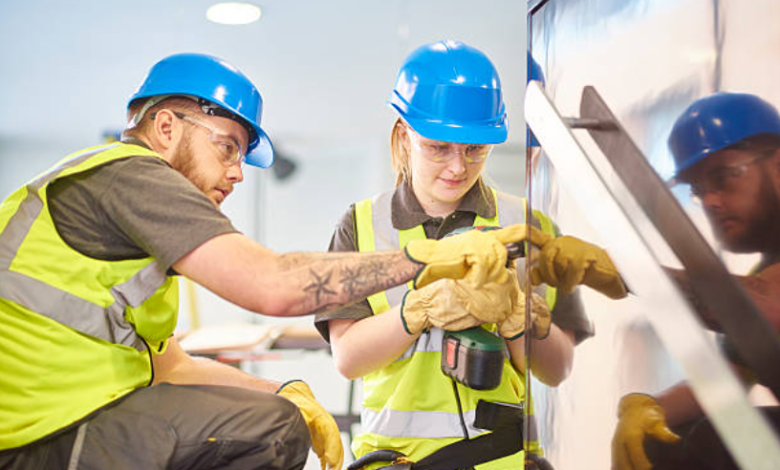Safety First: Best Practices for a Secure Construction Job Site

Construction job sites are bustling environments where workers, machinery, and materials come together to transform blueprints into reality. But with so much activity, these sites can also be hazardous if safety isn’t prioritized. Whether it’s preventing falls, managing heavy equipment, or ensuring workers are properly trained, creating a secure job site requires careful planning and consistent execution. Here are some best practices to keep construction projects safe and running smoothly.
1. Start with a Strong Safety Culture
A secure job site begins with mindset. Safety shouldn’t just be a checklist item—it needs to be part of the culture. Project managers, supervisors, and crew leaders must model safe practices and encourage open communication about risks. When workers feel empowered to speak up about unsafe conditions without fear of retaliation, hazards can be addressed quickly.
2. Provide Comprehensive Training
Training is one of the most effective ways to prevent accidents. All employees, from new hires to seasoned professionals, should undergo regular safety training tailored to their roles. Topics should include proper use of personal protective equipment (PPE), hazard recognition, emergency procedures, and safe equipment operation. Refresher courses help keep knowledge sharp and remind workers that safety is ongoing, not a one-time event.
3. Ensure Proper Use of Personal Protective Equipment (PPE)
PPE is the last line of defense against workplace hazards. Hard hats, safety glasses, gloves, high-visibility vests, and steel-toed boots are staples on most construction sites. Depending on the task, workers may also need hearing protection, harnesses, or respirators. Employers should provide the necessary gear, ensure it’s in good condition, and train workers on proper usage.
4. Maintain Clean and Organized Job Sites
Cluttered job sites are dangerous job sites. Tripping hazards, scattered tools, and poorly stored materials can lead to preventable accidents. Establishing routines for cleaning and organizing reduces risks and makes it easier for crews to work efficiently. Clearly marked walkways, designated storage areas, and waste disposal systems help keep order in an otherwise hectic environment.
5. Prioritize Fall Protection
Falls are one of the leading causes of injuries and fatalities in construction. To minimize risks, install guardrails, safety nets, and fall arrest systems where needed. Workers should always use harnesses when working at heights and be trained on how to properly secure them. Regular inspections of scaffolding, ladders, and platforms are also essential to ensure they meet safety standards.
See also: Hassle-Free Banking Designed for Business Owners
6. Conduct Regular Inspections and Audits
Safety isn’t something you can “set and forget.” Ongoing inspections of equipment, tools, and work areas help identify risks before they escalate. Supervisors should walk the site daily to spot hazards, and formal safety audits should be scheduled regularly. Documenting findings and implementing corrective actions ensures accountability and continuous improvement.
7. Use Technology to Enhance Safety
Modern technology is reshaping how construction sites manage safety. Wearable devices can monitor worker fatigue or exposure to hazardous environments, drones can conduct aerial inspections, and software platforms can track safety compliance. Integrating these tools not only reduces risks but also provides valuable data to prevent future incidents.
8. Establish Clear Emergency Procedures
Accidents can happen even on the safest job sites, so preparation is key. Every worker should know the emergency procedures for fires, medical incidents, and natural disasters. Job sites should have easily accessible first aid kits, fire extinguishers, and clearly marked evacuation routes. Conducting regular drills helps ensure that workers respond quickly and calmly in emergencies.
9. Promote Mental and Physical Well-Being
Safety goes beyond hard hats and harnesses—it’s about protecting the people who wear them. Fatigue, stress, and dehydration can cloud judgment and increase the risk of accidents. Employers can help by scheduling regular breaks, ensuring water is always available, and providing shaded areas or even a metal portable building in Lake Charles, LA for rest and recovery. Supporting mental health and overall well-being creates a workforce that’s not only cared for but also more alert, productive, and safe on the job site.
10. Lead by Example
Ultimately, leadership sets the tone for job site safety. Supervisors and managers who demonstrate safe behavior, enforce rules consistently, and recognize workers for following protocols send a powerful message: safety is non-negotiable. When leadership prioritizes safety, workers are more likely to follow suit.
Final Thoughts
A secure construction job site doesn’t happen by chance—it’s the result of deliberate effort, clear policies, and constant vigilance. By fostering a safety-first culture, equipping workers with training and PPE, and leveraging technology and inspections, construction companies can protect their teams while keeping projects on track. After all, no deadline or budget is worth more than the health and lives of the people building the future.





